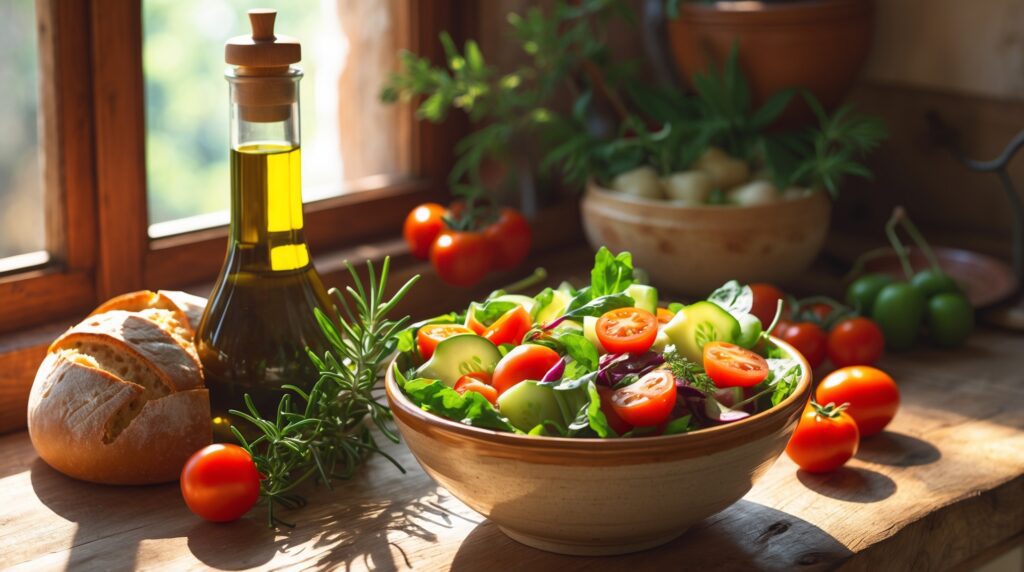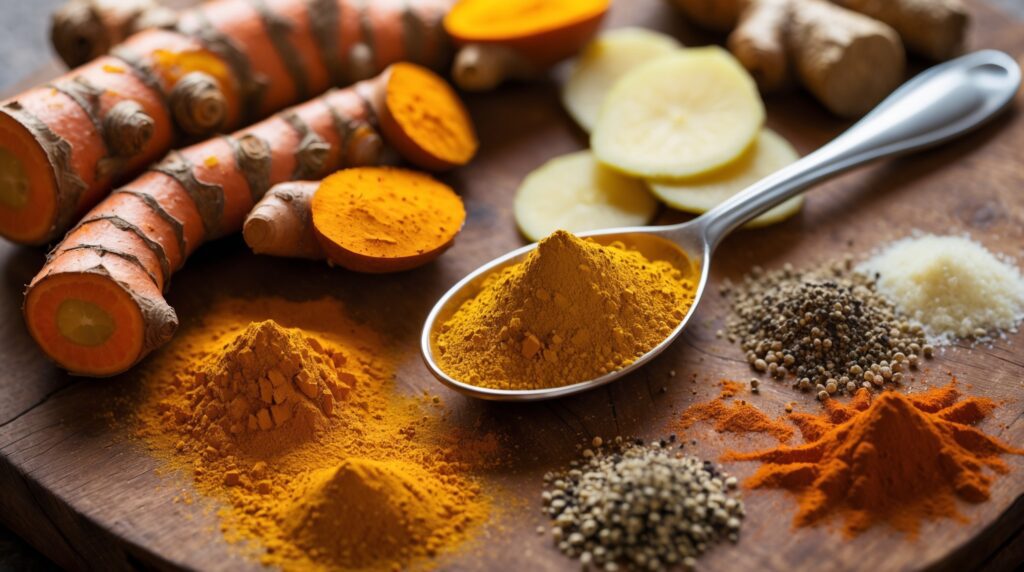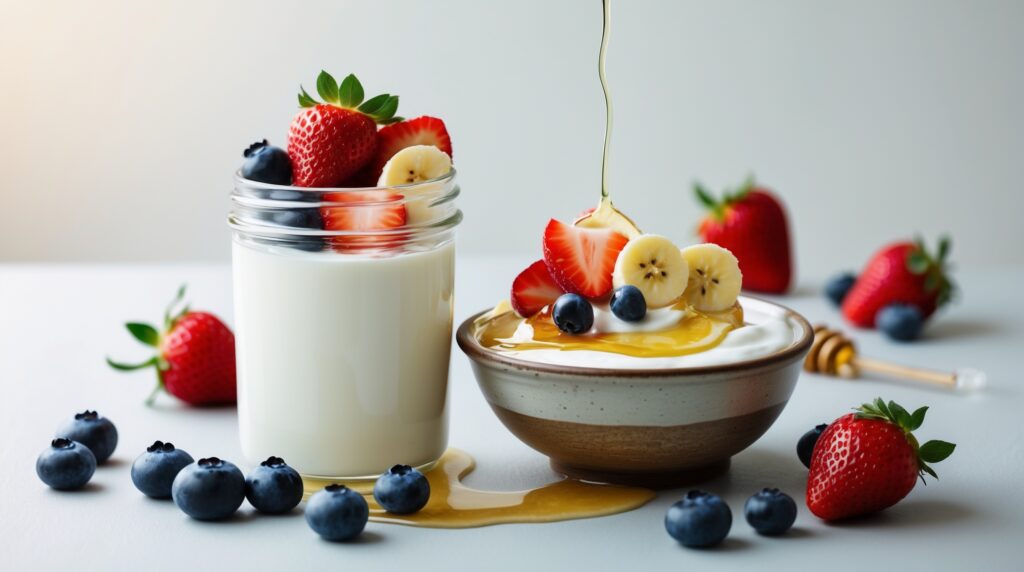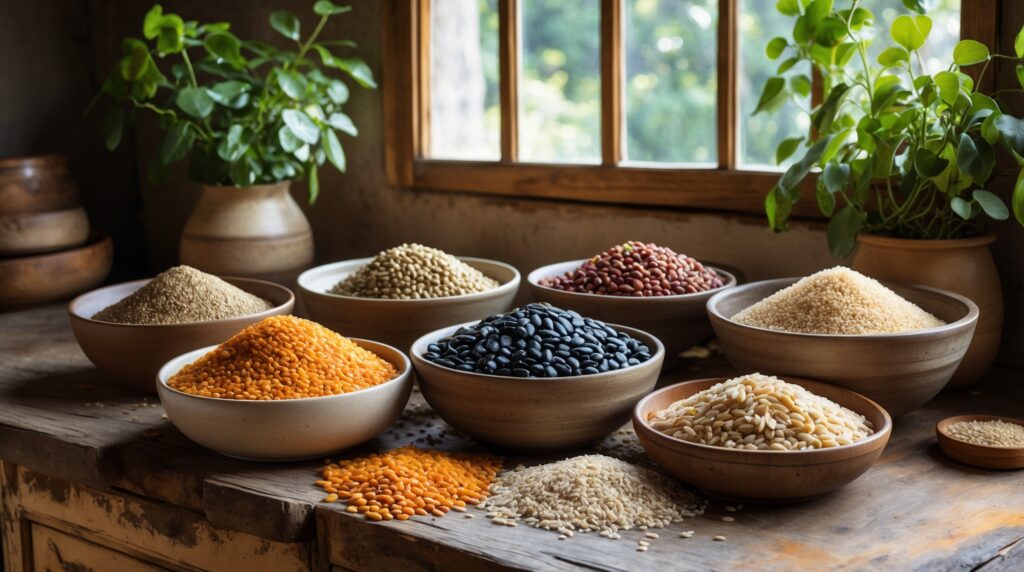You may have heard the word superfood quite many times and thought that maybe it’s a food that will give you some magic powers. The reality is that although some foods do hold great nutrition and make you energetic and healthy, the real joy and beauty of nature lie in its variety. In this article, we highlight 18 culturally rich superfoods from around the world that you might already be eating and can include in your daily diet for better health and longevity.
When we talk about culturally rich superfoods, we refer to foods that have been nourishing communities for centuries — combining flavor, tradition, and deep nutritional value. You must eat a balanced diet with a variety of these nutritious foods to stay healthy and active. Healthy dietary patterns not only let you enjoy nature’s diversity but also help reduce the risk of diseases such as heart disease, diabetes, high blood pressure, and some cancers too.
As the marketing companies related to the food industry have created a buzz around the word superfood to sell their products—and this term doesn’t seem to be fading anytime soon—we have compiled a list of some real culturally rich superfoods that are worthy enough to be recognized. This will help you know the actual options to choose from rather than getting caught up in the marketing hype.
You must plan your meals including a variety of them and not just rely on one single food, as it can never be enough to give you all the nutrition. Also remember, these are not the only options to choose from—you can always have other healthy foods but just be safe from unhealthy marketed products.
Read on to know about some culturally rich superfoods that have stood the test of time.
Olive Oil — A Mediterranean Cultural Superfood
This natural oil is mostly a main part of the Mediterranean diet, although now it is famous and used worldwide as a healthy fat alternative. What makes it so healthy is its high content of monounsaturated fatty acids and polyphenolic compounds.
 If you add it to your diet, it can lessen inflammation levels and prevent certain diseases such as diabetes and heart disease. The antioxidants including vitamins E and K also hold great significance as they reduce oxidative stress, which protects your cells and keeps them healthy.
If you add it to your diet, it can lessen inflammation levels and prevent certain diseases such as diabetes and heart disease. The antioxidants including vitamins E and K also hold great significance as they reduce oxidative stress, which protects your cells and keeps them healthy.
Berries — Antioxidant-Rich Global Superfoods
People who start eating healthy always include berries in their breakfast, dessert, salad, snack, or smoothies. Strawberries, blueberries, cranberries, raspberries, and blackberries are all good options to add to your diet.
 Not only are they rich sources of fiber, minerals, and vitamins, but they also give you strong antioxidant power to lessen the chances of cardiac issues, cancer, and some inflammatory diseases. They are good enough to make your immunity strong and improve your digestion. When your digestive system is working well, you absorb nutrients better, which improves your overall health and wellness.
Not only are they rich sources of fiber, minerals, and vitamins, but they also give you strong antioxidant power to lessen the chances of cardiac issues, cancer, and some inflammatory diseases. They are good enough to make your immunity strong and improve your digestion. When your digestive system is working well, you absorb nutrients better, which improves your overall health and wellness.
Avocado — One of the Most Loved Culturally Rich Superfoods
What makes it so special? Again, it’s the rich content of healthy fats, minerals, vitamins, and fiber. Just like olive oil, it also has monounsaturated fatty acids, especially oleic acid, which helps reduce inflammation in your body and prevent chronic diseases.
Salmon — A Nutrient-Dense Traditional Superfood
Omega-3 fatty acids particularly help with inflammation reduction. Eating salmon regularly makes you healthy as it not only lessens your risk of diabetes and cardiac problems but also helps with weight management.
You will get protein, omega-3 fatty acids, B vitamins, potassium, and selenium from salmon. However, eat it in moderation—2 to 3 servings per week—otherwise the heavy metals commonly found in seafood may harm you.
Dark Green Leafy Vegetables — Ancient Culturally Rich Superfoods
You may already have kale, collard greens, spinach, Swiss chard, and turnip greens in your curries, soups, pasta, and smoothies. If you want to improve your hemoglobin levels or regulate bowel movements, you must include them in your diet as they are good sources of folate and fiber. Not only this, they also give you vitamin C, zinc, magnesium, and calcium.
 They are capable of lessening your risk of severe diseases such as diabetes and heart disease. The anti-inflammatory carotenoids also give them anti-cancer properties. Plant-based foods play a major role in longevity and overall wellness. Read more in Top 5 Health Benefits of a Plant-Based Diet Backed By Science.
They are capable of lessening your risk of severe diseases such as diabetes and heart disease. The anti-inflammatory carotenoids also give them anti-cancer properties. Plant-based foods play a major role in longevity and overall wellness. Read more in Top 5 Health Benefits of a Plant-Based Diet Backed By Science.
Nuts and Seeds — Tiny Culturally Rich Superfoods
Most people enjoy nuts in winter, but few know that eating seeds is also equally healthy. When you have them in balanced amounts, they even aid you with weight management.
Nuts and seeds enrich you with plant proteins, fiber, healthy fats, antioxidants, and anti-inflammatory compounds. Their special role is in preventing the risk of heart disease. So next time, not just add almonds, peanuts, cashews, walnuts, Brazil nuts, or hazelnuts to your yogurt, oatmeal, snacks, or veggies—also try flaxseeds, chia seeds, pumpkin seeds, and sunflower seeds.
Mushrooms — Cultural Cuisine’s Hidden Superfoods
Nowadays, they are only limited to our pizzas, but remember this sustainable and healthy food choice deserves to be part of your regular meals. Although different varieties give different nutrients, generally speaking they have fiber, some disease-fighting antioxidants not found in other foods, potassium, and vitamin A.
You can have shiitake, oyster, button, crimini, and Portobello mushrooms.
Legumes — Traditional Superfoods for Every Culture
Don’t ever ignore them. Some people enjoy chicken and fish but are never a fan of vegetables and legumes. Beans and lentils are brimming with nutrients—particularly protein, fiber, minerals, and B vitamins.
From weight management and blood sugar control to blood pressure and cholesterol management, legumes can help you with everything. If you enjoy legumes in your curries, soups, spreads, and salads, you are going in the right direction.
Green Tea — A Centuries-Old Asian Superfood
This beverage is mostly popular as a weight loss remedy, but it also gives you plenty of anti-inflammatory polyphenolic compounds and antioxidants, especially the chronic disease protector epigallocatechin gallate.
 If you are trying to eat healthy, you must make this beverage part of your diet as it can protect you against cancer, heart disease, diabetes, and obesity. For those practicing fasting or mindful eating, our post on10 Science-Backed Intermittent Fasting Benefits You Must Know explains how fasting complements superfoods like green tea to improve metabolism and cellular health.”
If you are trying to eat healthy, you must make this beverage part of your diet as it can protect you against cancer, heart disease, diabetes, and obesity. For those practicing fasting or mindful eating, our post on10 Science-Backed Intermittent Fasting Benefits You Must Know explains how fasting complements superfoods like green tea to improve metabolism and cellular health.”
Sweet Potato — A Global Comfort Superfood
As the name suggests they do have sweet flavor, but actually help you manage your blood sugar levels. Sweet potatoes enrich you with fiber, vitamins A and C, potassium, and cancer-fighting carotenoids.
Managing your blood sugar naturally becomes easier when you pair these nutrient-rich foods with smart habits — discover practical tips in 5 Easy Ways to Manage Your Blood Glucose Levels Naturally.
Eggs — Everyday Cultural Superfoods
If you are not allergic to eggs, you must already have them at least once in your breakfast. This healthiest food option gives you good content of vitamin A, B vitamins, high-quality protein, selenium, iron, choline and antioxidants lutein and zeaxanthin which are good for your eyes too.
You can have 6–12 eggs weekly without the risk of cholesterol increase, or heart disease. They even aid in increasing your good cholesterol levels.
Turmeric and Ginger — Culturally Rich Healing Superfoods
Mostly common in the Indian subcontinent, turmeric with its active and potent antioxidant and anti-inflammatory compound curcumin is capable of protecting you against chronic diseases of cancer, diabetes, and heart disease. It also supports pain reduction and wound healing.
 When you include it in your curries with black pepper or fats, its absorption increases in your body.
When you include it in your curries with black pepper or fats, its absorption increases in your body.
Not only does ginger enhance the flavor of your foods such as curries, sauces, and soups, but the antioxidant gingerol in it also gives you many health benefits. Ginger tea is good for reducing nausea and pain from inflammatory conditions. Your risk of memory loss, heart disease, and cancer also lessen with it. If you’re interested in reducing inflammation naturally, explore our detailed guide on the Anti-Inflammatory Diet 101 – What To Eat And What To Avoid For Better Health to see how everyday foods can help protect your body.
Seaweed — Ocean’s Culturally Rich Superfood
Previously, only a few people knew about this healthy and nutritious sea vegetable, but now it is gaining popularity. It has unique antioxidants not found in land vegetables, protecting you against weight gain, cancer, cardiac issues, and diabetes. Also, it has good amounts of fiber, folate, iodine, and vitamin K content.
Tomatoes — A Universal Cultural Superfood
Tomato, a vital part of your salads, curries, rice, pasta, soups, and sauces, is rich in vitamin C and lycopene, which makes it quite healthy. When tomatoes are heated in olive oil during cooking, their lycopene content becomes more available.
Garlic — A Culturally Trusted Superfood
This flavor enhancer is not something to be taken lightly as it also offers several nutrients including fiber, vitamin C, selenium, manganese, and vitamin B6. Garlic is widely used in weight loss programs. Also, it has benefits related to cholesterol and blood pressure control. Garlic is capable of making your immunity strong, hence protecting you from diseases.
Kefir and Yogurt — Probiotic-Rich Culturally Loved Superfoods
Although not so popular, kefir is similar to yogurt but with richer probiotic content. Kefir is made by fermenting milk, either dairy like cow’s milk or non-dairy like almond milk. You can enjoy it in smoothies or shakes. It also gives you protein, calcium, potassium, and vitamins.
 Probiotics not only protect the body from harmful bacteria but also help in managing blood pressure, lowering cholesterol, improving digestion, and conferring anti-inflammatory actions. Make it at home or buy one without added sugars. Yogurt with live active cultures of L. bulgaricus, L. acidophilus, and Lactobacillus is also a good healthy option.
Probiotics not only protect the body from harmful bacteria but also help in managing blood pressure, lowering cholesterol, improving digestion, and conferring anti-inflammatory actions. Make it at home or buy one without added sugars. Yogurt with live active cultures of L. bulgaricus, L. acidophilus, and Lactobacillus is also a good healthy option.
Whole Grains — Everyday Culturally Rich Superfoods
How to forget these phytonutrient-rich grains you have daily in your meals? They can manage your cholesterol and blood sugar levels and reduce the risk of diabetes and heart disease. You will get lots of minerals, B vitamins, and fiber from them. Your oatmeal bowl in the morning, quinoa salad at lunch, or brown rice at dinner are all now legal to eat.

The Takeaway: Embrace Culturally Rich Superfoods for Lifelong Health
Try to understand nature—it thrives on variety. In the same way, we should bring variety into our diets to stay healthy. Diet plans based on one particular food group don’t work well to achieve your goal of optimal health. Make it your priority to enjoy nature’s diversity and better health by including multiple foods from the list above.
Including these 18 culturally rich superfoods in your meals daily is a timeless way to nourish your body, honor global food traditions, and enjoy long-term wellbeing. To keep exploring more health-boosting foods and research-backed nutrition tips, visit our Healthabulous Articles for more inspiring reads.
References
Slavin JL, Jacobs D, Marquart L, Wiemer K. The role of whole grains in disease prevention. J Am Diet Assoc. 2001 Jul;101(7):780-5. doi: 10.1016/S0002-8223(01)00194-8. PMID: 11478475.
Collins EJ, Bowyer C, Tsouza A, Chopra M. Tomatoes: An Extensive Review of the Associated Health Impacts of Tomatoes and Factors That Can Affect Their Cultivation. Biology (Basel). 2022 Feb 4;11(2):239. doi: 10.3390/biology11020239. PMID: 35205105; PMCID: PMC8869745.
Rosa DD, Dias MMS, Grześkowiak ŁM, Reis SA, Conceição LL, Peluzio MDCG. Milk kefir: nutritional, microbiological and health benefits. Nutr Res Rev. 2017 Jun;30(1):82-96. doi: 10.1017/S0954422416000275. Epub 2017 Feb 22. PMID: 28222814.
Adaki S, Adaki R, Shah K, Karagir A. Garlic: Review of literature. Indian J Cancer. 2014 Oct-Dec;51(4):577-81. doi: 10.4103/0019-509X.175383. PMID: 26842201.
Terry R, Posadzki P, Watson LK, Ernst E. The use of ginger (Zingiber officinale) for the treatment of pain: a systematic review of clinical trials. Pain Med. 2011 Dec;12(12):1808-18. doi: 10.1111/j.1526-4637.2011.01261.x. Epub 2011 Nov 4. PMID: 22054010.
Azam F, Amer AM, Abulifa AR, Elzwawi MM. Ginger components as new leads for the design and development of novel multi-targeted anti-Alzheimer’s drugs: a computational investigation. Drug Des Devel Ther. 2014 Oct 23;8:2045-59. doi: 10.2147/DDDT.S67778. PMID: 25364231; PMCID: PMC4211852.
Rastogi S, Pandey MM, Rawat AKS. Spices: Therapeutic Potential in Cardiovascular Health. Curr Pharm Des. 2017;23(7):989-998. doi: 10.2174/1381612822666161021160009. PMID: 27774899.
Westerterp-Plantenga MS. Green tea catechins, caffeine and body-weight regulation. Physiol Behav. 2010 Apr 26;100(1):42-6. doi: 10.1016/j.physbeh.2010.02.005. Epub 2010 Feb 13. PMID: 20156466.
Ooi CP, Loke SC. Sweet potato for type 2 diabetes mellitus. Cochrane Database Syst Rev. 2013 Sep 3;2013(9):CD009128. doi: 10.1002/14651858.CD009128.pub3. PMID: 24000051; PMCID: PMC6486146.
Gray B, Steyn F, Davies PS, Vitetta L. Omega-3 fatty acids: a review of the effects on adiponectin and leptin and potential implications for obesity management. Eur J Clin Nutr. 2013 Dec;67(12):1234-42. doi: 10.1038/ejcn.2013.197. Epub 2013 Oct 16. PMID: 24129365.
Zivkovic AM, Telis N, German JB, Hammock BD. Dietary omega-3 fatty acids aid in the modulation of inflammation and metabolic health. Calif Agric (Berkeley). 2011 Jul;65(3):106-111. doi: 10.3733/ca.v065n03p106. PMID: 24860193; PMCID: PMC4030645.
Xavier AA, Pérez-Gálvez A. Carotenoids as a Source of Antioxidants in the Diet. Subcell Biochem. 2016;79:359-75. doi: 10.1007/978-3-319-39126-7_14. PMID: 27485230.
Wang PY, Fang JC, Gao ZH, Zhang C, Xie SY. Higher intake of fruits, vegetables or their fiber reduces the risk of type 2 diabetes: A meta-analysis. J Diabetes Investig. 2016 Jan;7(1):56-69. doi: 10.1111/jdi.12376. Epub 2015 Jun 22. PMID: 26816602; PMCID: PMC4718092.
Kozarski M, Klaus A, Jakovljevic D, Todorovic N, Vunduk J, Petrović P, Niksic M, Vrvic MM, van Griensven L. Antioxidants of Edible Mushrooms. Molecules. 2015 Oct 27;20(10):19489-525. doi: 10.3390/molecules201019489. PMID: 26516828; PMCID: PMC6331815.
Polak R, Phillips EM, Campbell A. Legumes: Health Benefits and Culinary Approaches to Increase Intake. Clin Diabetes. 2015 Oct;33(4):198-205. doi: 10.2337/diaclin.33.4.198. PMID: 26487796; PMCID: PMC4608274.
Nocella C, Cammisotto V, Fianchini L, D’Amico A, Novo M, Castellani V, Stefanini L, Violi F, Carnevale R. Extra Virgin Olive Oil and Cardiovascular Diseases: Benefits for Human Health. Endocr Metab Immune Disord Drug Targets. 2018;18(1):4-13. doi: 10.2174/1871530317666171114121533. PMID: 29141571.
Govers C, Berkel Kasikci M, van der Sluis AA, Mes JJ. Review of the health effects of berries and their phytochemicals on the digestive and immune systems. Nutr Rev. 2018 Jan 1;76(1):29-46. doi: 10.1093/nutrit/nux039. PMID: 29087531.
Manganaris GA, Goulas V, Vicente AR, Terry LA. Berry antioxidants: small fruits providing large benefits. J Sci Food Agric. 2014 Mar 30;94(5):825-33. doi: 10.1002/jsfa.6432. Epub 2013 Nov 5. PMID: 24122646.
Sales-Campos H, Souza PR, Peghini BC, da Silva JS, Cardoso CR. An overview of the modulatory effects of oleic acid in health and disease. Mini Rev Med Chem. 2013 Feb;13(2):201-10. PMID: 23278117.


